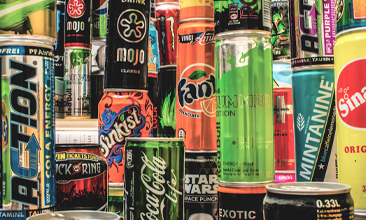Can energy drinks really deliver days filled with vitality, excitement and adventure? An increasing number of exhausted parents and sleep-deprived teens reach for energy drinks to increase stamina, concentration and focus. But before you say “yay” to energy drinks, let’s look at the facts behind the hype.
What Are Energy Drinks?
Just like sports drinks, energy drinks are flavored beverages that contain water, carbohydrates, vitamins and minerals. The difference between energy drinks and sports drinks is the amount of caffeine and other stimulants they contain. The caffeine content of an energy drink can vary from about 80 mg to more than 400 mg. In comparison, a 5-ounce cup of coffee contains about 100 mg and a 12-ounce cola about 50 mg. The impact of other stimulants found in energy drinks, such as Taurine or Guarana, may not be known.
Energy drinks can be harmful to children. The American Academy of Pediatrics cautions that “caffeine and other stimulant substances contained in energy drinks have no place in the diet of children and adolescents.”
What Is Caffeine?
Caffeine occurs naturally in plant sources like coffee beans, tea leaves and cacao beans, which are used to make chocolate. Some foods, beverages and medicines contain synthetic caffeine, added during the manufacturing process. Caffeine is a stimulant that acts on the brain and central nervous system to make you more alert and awake. It does this by blocking a neurotransmitter that promotes sleep and relaxation. That’s why caffeine can cause problems with your ability to go to sleep or stay asleep.
Why Is Caffeine Bad for Kids?
Caffeine has no nutritional benefit and can cause dangerous reactions in some children. The number of visits to the emergency room related to energy drink consumption is increasing, according to the Center for Behavioral Health Statistics and Quality.
The levels of caffeine in energy drinks can affect the cardiovascular system, causing elevated blood pressure, fast heart rate, cardiac arrhythmias and even cardiac arrest or stroke. In some people, excessive caffeine can cause anxiety and restlessness or make anxiety disorders worse. So why are these products marketed to teenagers and sold without age limits or restrictions?
Why Are Energy Drinks Sold Without Restrictions?
The FDA doesn’t regulate whether manufacturers market beverages as dietary supplements or conventional foods. Dietary supplements that contain stimulants, such as caffeine, must be labeled with a warning as well as the amount of the stimulant. For example, Vivarin packaging discloses that one tablet contains 200 mg of caffeine. Package warnings include “Do not use in children under 12 years old.” “Limit caffeine-containing medications, foods, or beverages because too much caffeine may cause nervousness, irritability, sleeplessness and, occasionally, rapid heartbeat.”
Manufacturers of conventional foods aren’t required to provide caffeine content on the package labeling, although some do voluntarily. It is up to parents to say “nay” to energy drink consumption for their kids.
What Parents Can Do
Take action to protect your children from the dangers of energy drinks and excessive levels of caffeine:
- Make energy drinks off-limits. Don’t allow your children to buy them when you’re out shopping. Don’t keep them in your house.
- Make sure your children know the difference between energy drinks and sports drinks. Marketing for energy drinks and sports drinks are similar—it’s easy for kids to think they are the same. Teens might choose an energy drink instead of a sports drink for rehydrating after physical exercise.
- Talk to your children about what they drink at school. Some schools sell energy drinks in vending machines and snack bars or the cafeteria. The CDC reports that 75% of school districts have no policies prohibiting the sale of beverages that contain high levels of caffeine. Encourage your children to drink water instead of sports or energy drinks.
- Educate your children. Have conversations about the dangers of energy drinks and excessive caffeine consumption. Teach them the amounts of caffeine in common beverages and foods. Caffeine from different sources can add up.
Brenda Schoolfield is a medical writer and editor who lives in Austin. Sugar, her cocker spaniel and sometimes a rescue foster dog or two keep her company while she writes.




















